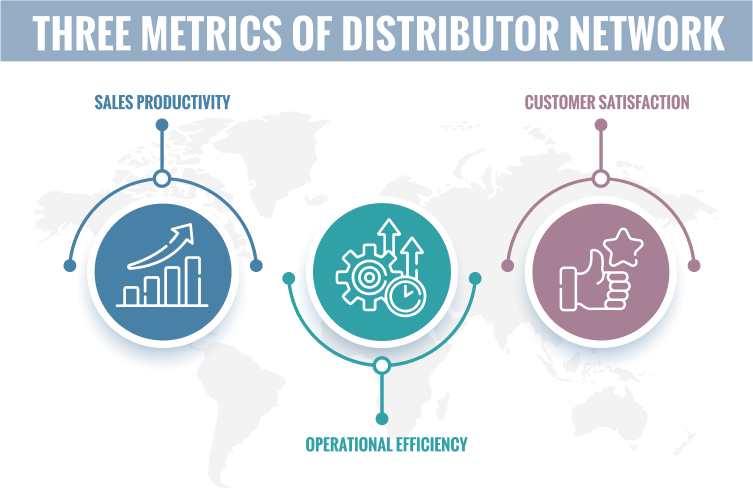A distributor network is a source for both boosting sales and understanding consumer trends. Through the help of different metrics, brands can determine how they fare against their competitors, identify the areas for improvement, and find new ways to target the right consumers. It’s also an effective way to understand the distributor network’s efficiency and find ways to improve the distribution and sales numbers.
There are various metrics that brands can track. But we have segregated them into three categories to help brands measure the distributor network’s efficiency.
Three Metrics to Measure the Performance of Distributor Network
1. Sales Productivity
65% of B2B companies consider sales productivity the number one challenge they face every day. By definition, sales productivity measures the downstream sales team’s performance in achieving the targets. In this case, the sales team is the distributor network that sells the products to the end-users. There are various ways to measure sales productivity. For example, FMCG brands measure the effectively covered outlet (ECO). It measures how many outlets actively make at least one sales memo a month on a particular route or territory. It also tells them how many outlets are active and how many are dormant so that they can focus on making the dormant ones functional. B2B companies use different metrics such as the time spent on running demos and the percentage of closed deals. These metrics will help the brands identify the possible bottlenecks in boosting sales and focus on empowering the distributors to make better sales.
2. Operational Efficiency
Brands often focus less than they could on the value of operational efficiency. But tracking metrics such as inventory and logistics is important to improve the efficiency of the distributor network. Brands must track metrics such as:
- Throughput: Throughput helps brands understand how well the distributors’ warehouses manage their order fulfilment process within a specific time. It measures how well the staff at the warehouse are utilized to fulfil the orders and replenish them to fill the stocks.
- Inventory turnover rate: Inventory turnover rate allows brands to measure the number of times an inventory is sold and replaced within a specific period. It helps the distributors to track and predict the inventory usage and replenish the stock on time to avoid stock-outs.
- Order accuracy rate: The order accuracy rate helps brands understand how many orders out of total orders are delivered to the customers accurately by the distributors. It’s estimated that the order accuracy rate must be above 98% for maximum effectiveness. An accuracy rate below that would mean that the brand must work more closely with distributors to identify and fix the problem immediately. For example, there could be discrepancies in the order picking and delivering process. Identifying these gaps and fixing them on time will help both distributors and the brand deliver the right orders on time.
- Order cycle time: Order cycle time is a great indicator of operational efficiency. It measures the average time taken to deliver the order from when it was placed. However, it does not include the actual shipping time. The shorter the order cycle time, the better it would be for the brand’s reputation and customer satisfaction.
- Time to ship: This metric helps brands evaluate the amount of time taken to ship an order from the time the order is validated and packaged. The key point to note here is that it calculates the time taken to ship the product from the distributors’ warehouse. It doesn’t calculate the time taken to deliver the product to the customer.
- Sales order fill rate: This metric calculates the percentage of orders that can be fulfilled with the existing inventory. It helps distributors keep track of their inventory and update the stocks accurately.
3. Customer Satisfaction
Distributors have a terribly important role to play in building a customer-centric brand. Everything can make or break the brand’s reputation, from on-time delivery to customer support. Here are some metrics that brands must measure to determine how distributors interact and serve the customers.
- On-time delivery: It measures the total number of orders delivered on time to the customer. It helps brands understand the efficiency of the distributor network.
- Customer complaint resolution: This metric will determine how quickly the distributors solve the customer’s complaints. If the complaints from customers are repetitive such as shipping delays or damaged products, distributors can get to the root of the issue and resolve it.
- Undamaged delivery rate: It measures the total number of orders delivered without any damage. Higher the number of undamaged products, better the customer satisfaction. If the number of damaged orders is high, the distributors will have to find out its cause and take corrective measures.
- Sales lost due to out-out-stock products: Frequent out-of-stock products could damage the brand’s reputation and lead to losses. This metric will help brands find out if the distributors have a good inventory management process in place. If the distributors lose sales or have to refund the customer’s payment frequently due to out-of-stock products, they must reassess their inventory management process and improve it.
The Role of Data Analytics in Tracking Metrics
Data plays a significant role in tracking and measuring the different metrics. Distributors share regular reports with brands to give them an overview of their sales performance. Brands compare the reports of different distributors and identify the high-performing ones and the ones that might need more support to improve sales. Data gives them valuable insights on metrics that can be improved to boost sales. However, collecting data from the distributor network is a challenge for brands. Brands receive poor quality data and non-standardized, complex data formats from different distributors. They have a tough time making sense of the data and making correct decisions. It is also time-consuming and error-prone. One way to solve this problem is by using data aggregators.
How Data Aggregators Can Help Track Metrics
Data aggregators can help brands unite data from their distributor networks at once with just a click of a finger. It will give them an overview of the sales performance of different distributors. It also allows the brands to perform deeper analysis to improve sales numbers and find future opportunities to sell products.
To help brands make sense of their data, we have built an aggregator solution called iSteer Aggregator.
iSteer Aggregator collects raw data from different sources and publishes it in an intelligible form to help brands dive into the complexities and enable them to make better decisions by identifying patterns and trends in data.
To find out how iSteer Aggregator can help optimize and improve the performance of the distributor network, contact us. We will schedule a free demo to demonstrate its performance.




